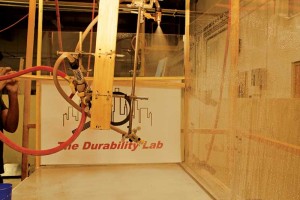Understanding why doors leak

Testing
The authors designed an experiment to simulate rainfall on an accessible door and the resulting ‘pile-up’ of water at the threshold. A 12-mm (½-in.) tall aluminum threshold was installed on a platform to recreate the geometry of a 2010 ADA Standards-compliant door and adjacent walkway. Rather than installing an actual door, clear Plexiglas was sealed to the top of the threshold to facilitate observations. The testing platform was hinged to allow varying the slope. Square-pattern nozzles uniformly sprayed water downward over the platform, simulating idealized vertical rainfall of varying intensity. An additional hinged nozzle simulated the water cascading down the building envelope, as well as angled rainfall.
At a downward spray rate of 203 mm (8 in.) per hour, nothing remarkable happened—the water easily drained off the threshold. In fact, the spray was so light it was difficult to fathom this would surpass the highest sustained rainfall in the United States. Even doubling the downward spray rate (to mimic short duration peak intensity storms) did not cause any accumulation.
Similarly, a horizontal spray equivalent to 203 mm per hour (similar to the standard water test methods) directed at the Plexiglas above the threshold did not cause much accumulation. As the water flowed down the ‘door’ and hit the bottom, the resulting rebound caused minor disturbances to the water flow. The rebound effects compounded the turbulence resulting from the sudden change in direction of the water flow from vertical to horizontal. This led to a momentary stagnation of water at the threshold, and caused the water to begin to accumulate.
However, turning the nozzle to spray the threshold at an angle caused water to accumulate up to 25 mm (1 in.) high, which causes more pressure than standard weatherstripping can withstand. As anyone caught in a downpour has noticed, storms blow rain at an angle, rather than vertically or horizontally. Unfortunately, this natural condition turns out to be the worst case for a marginal threshold. Due to the low slope, the vector of water directed toward the threshold overcame the water trying to flow away from the threshold by gravity. The tests were done with static conditions—introducing wind and wave action on the already submerged threshold would obviously exacerbate the leakage.
Increasing the slope of the platform made no measurable difference (even if this were allowed by code). Eddies were observed very close to the door threshold, caused mainly by the geometry at the interface of the threshold and platform. As the water falling in front of the threshold was already turbulent, this geometry further aggravated conditions. At about 0.3 m (1 ft) from the threshold, laminar flow returned, with very few flow instabilities observed for all experimentation conditions. Of course, this is too far from the threshold to be helpful—the turbulence at the threshold is all that matters to leakage.

Recommendations
Attention to detail in construction of exterior doorways can limit water infiltration through most of the paths previously outlined. Where accessible doors are required by code, high-quality door manufacturing design and fabrication can help with improved pressure resistance, hardware, and weatherstripping, as can selecting out-swing doors with a ‘bump’ threshold. However, accessible doors have an inherent weakness—low threshold and low slope. With only a 12-mm (½-in.) threshold height allowed, it is not reasonable to expect an accessible door to be watertight. Therefore, the authors believe the building design should protect exterior doors from direct impinging rainfall by alcoves, roofs, canopies, awnings, or overhangs.
To remedy leaking doors on buildings where adding protection was deemed aesthetically unacceptable, we have had success installing trench drains across doorways. However, these drains have to be surprisingly large— to be effective, they must instantly drain the water that would otherwise accumulate against the threshold. Just as accessibility requirements govern the threshold’s height and the adjacent walking surface’s slope, they also dictate ‘heel-proof’ grates have small holes instead of the large industrial trench grates that would drain faster.
Conclusion
It may seem obvious to recommend collaboration of all stakeholders to achieve project success, but for exterior doors it is essential. Issues related to waterproofing, accessibility, and aesthetics compete with each other, requiring a comprehensive, balanced approach to achieve
a leak-free, attractive, and code-compliant envelope. Ultimately, it is failure to collaborate that leads to finger-pointing when the doors leak.
Adrian Gerard Saldanha is completing his master’s degree in construction engineering and project management at the University of Texas at Austin (UT). He is a graduate research assistant in The Durability Lab—a testing center at UT established by Building Diagnostics Inc., to study the durability of building components, identifying factors causing premature failure. He can be contacted at asaldanha@buildingdx.com.
David H. Nicastro, PE, is the founder of Engineering Diagnostics Inc. and Building Diagnostics Inc.—firms specializing in the investigation of problems with existing buildings, designing remedies for those problems, and resolving disputes which arise from them. He is a licensed professional engineer, and leads the research being performed at The Durability Lab. Nicastro has published more than 50 articles on durability of building components. He can be reached by e-mail at dnicastro@buildingdx.com.






